engine LOTUS ELISE 2005 Owner's Guide
[x] Cancel search | Manufacturer: LOTUS, Model Year: 2005, Model line: ELISE, Model: LOTUS ELISE 2005Pages: 205, PDF Size: 4.51 MB
Page 74 of 205
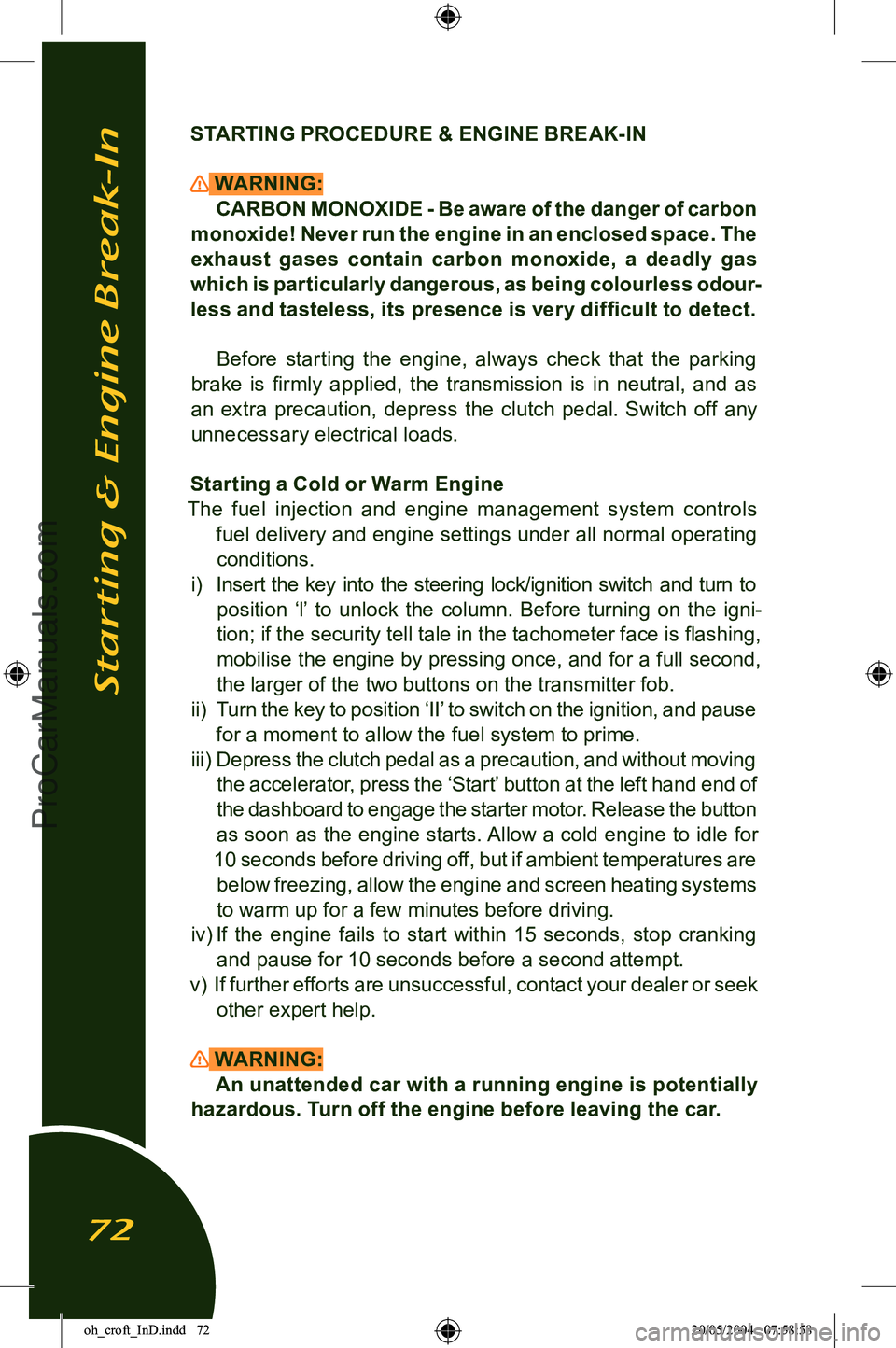
STARTING PROCEDURE & ENGINE BREAK-IN
WARNING:CARBON MONOXIDE - Be aware of the danger of carbon
monoxide! Never run the engine in an enclosed space. The
exhaust gases contain carbon monoxide, a deadly gas
which is particularly dangerous, as being colourless odour
-
less and tasteless, its presence is very difficult to detect.
Before starting the engine, always check that the parking
brake is firmly applied, the transmission is in neutral, and as
an extra precaution, depress the clutch pedal. Switch off any
unnecessary electrical loads.
Starting a Cold or Warm Engine
The fuel injection and engine management system controls fuel delivery and engine settings under all normal operating conditions.
i) Insert the key into the steering lock/ignition switch and turn to
position ‘l’ to unlock the column. Before turning on the igni
-
tion; if the security tell tale in the tachometer face is flashing, mobilise the engine by pressing once, and for a full second,
the larger of the two buttons on the transmitter fob.
ii) Turn the key to position ‘II’ to switch on the ignition, and pause
for a moment to allow the fuel system to prime.
iii) Depress the clutch pedal as a precaution, and without moving
the accelerator, press the ‘Start’ button at the left hand end of
the dashboard to engage the starter motor. Release the button
as soon as the engine starts. Allow a cold engine to idle for
10 seconds before driving off, but if ambient temperatures are below freezing, allow the engine and screen heating systems
to warm up for a few minutes before driving.
iv) If the engine fails to start within 15 seconds, stop cranking
and pause for 10 seconds before a second attempt.
v) If further efforts are unsuccessful, contact your dealer or seek
other expert help.
WARNING:
An unattended car with a running engine is potentially
hazardous. Turn off the engine before leaving the car.
Starting & Engine Break-In
72
oh_croft_InD.indd 7220/05/2004 07:58:58ProCarManuals.com
Page 75 of 205
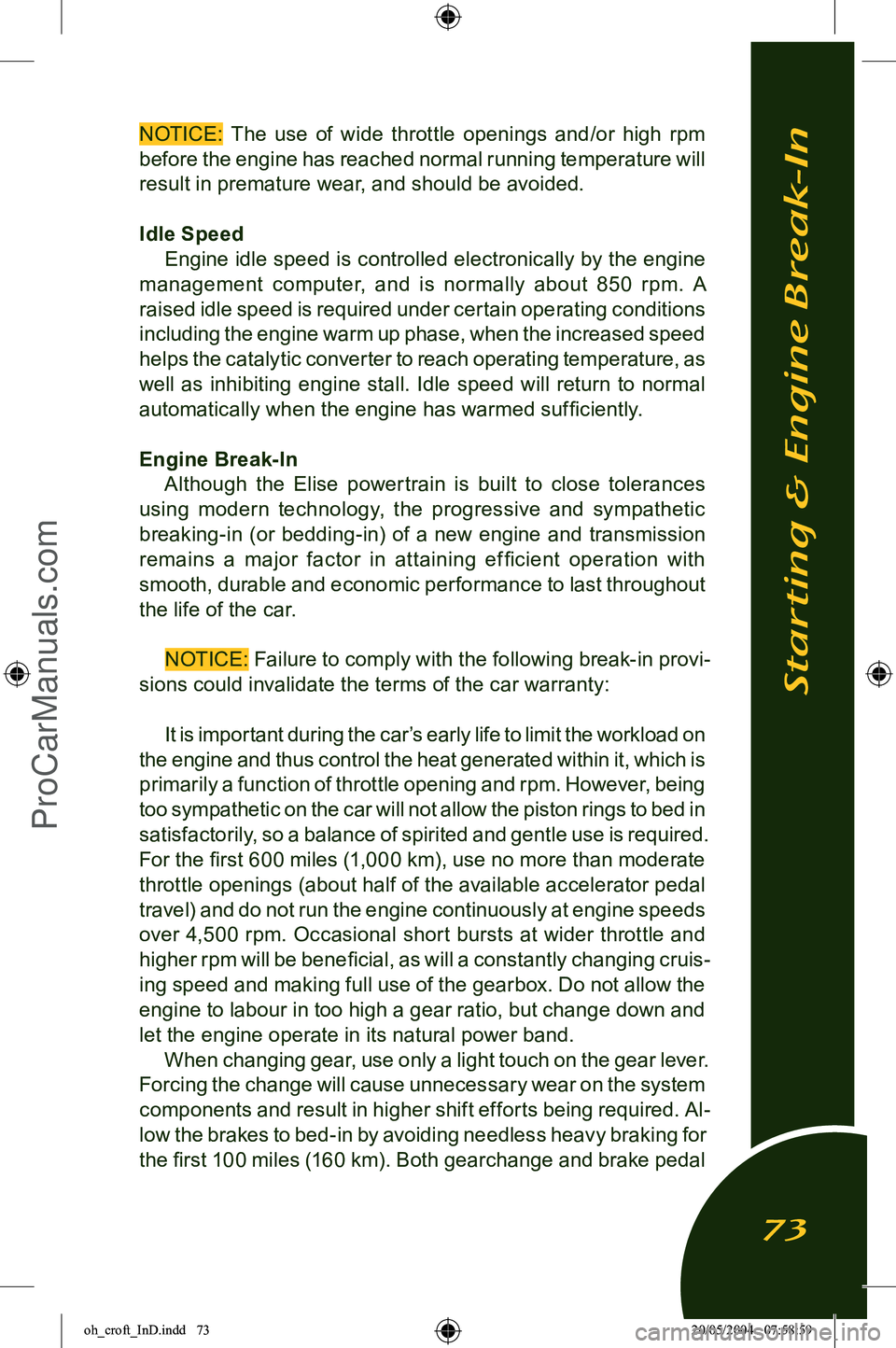
NOTICE: The use of wide throttle openings and/or high rpm before the engine has reached normal running temperature will
result in premature wear, and should be avoided.
Idle Speed Engine idle speed is controlled electronically by the engine
management computer, and is normally about 850 rpm. A
raised idle speed is required under certain operating conditions
including the engine warm up phase, when the increased speed helps the catalytic converter to reach operating temperature, as
well as inhibiting engine stall. Idle speed will return to normal automatically when the engine has warmed sufficiently.
Engine Break-In Although the Elise powertrain is built to close tolerances
using modern technology, the progressive and sympathetic
breaking-in (or bedding-in) of a new engine and transmission
remains a major factor in attaining ef ficient operation with
smooth, durable and economic performance to last throughout
the life of the car.
NOTICE: Failure to comply with the following break-in provi
-
sions could invalidate the terms of the car warranty:
It is important during the car’s early life to limit the workload on
the engine and thus control the heat generated within it, which is primarily a function of throttle opening and rpm. However, being
too sympathetic on the car will not allow the piston rings to bed in
satisfactorily, so a balance of spirited and gentle use is required.
For the first 600 miles (1,000 km), use no more than moderate
throttle openings (about half of the available accelerator pedal
travel) and do not run the engine continuously at engine speeds over 4,500 rpm. Occasional short bursts at wider throttle and
higher rpm will be beneficial, as will a constantly changing cruis
-
ing speed and making full use of the gearbox. Do not allow the
engine to labour in too high a gear ratio, but change down and
let the engine operate in its natural power band. When changing gear, use only a light touch on the gear lever.
Forcing the change will cause unnecessary wear on the system components and result in higher shift efforts being required. Al
-
low the brakes to bed-in by avoiding needless heavy braking for
the first 100 miles (160 km). Both gearchange and brake pedal
Starting & Engine Break-In
73
oh_croft_InD.indd 7320/05/2004 07:58:59ProCarManuals.com
Page 76 of 205
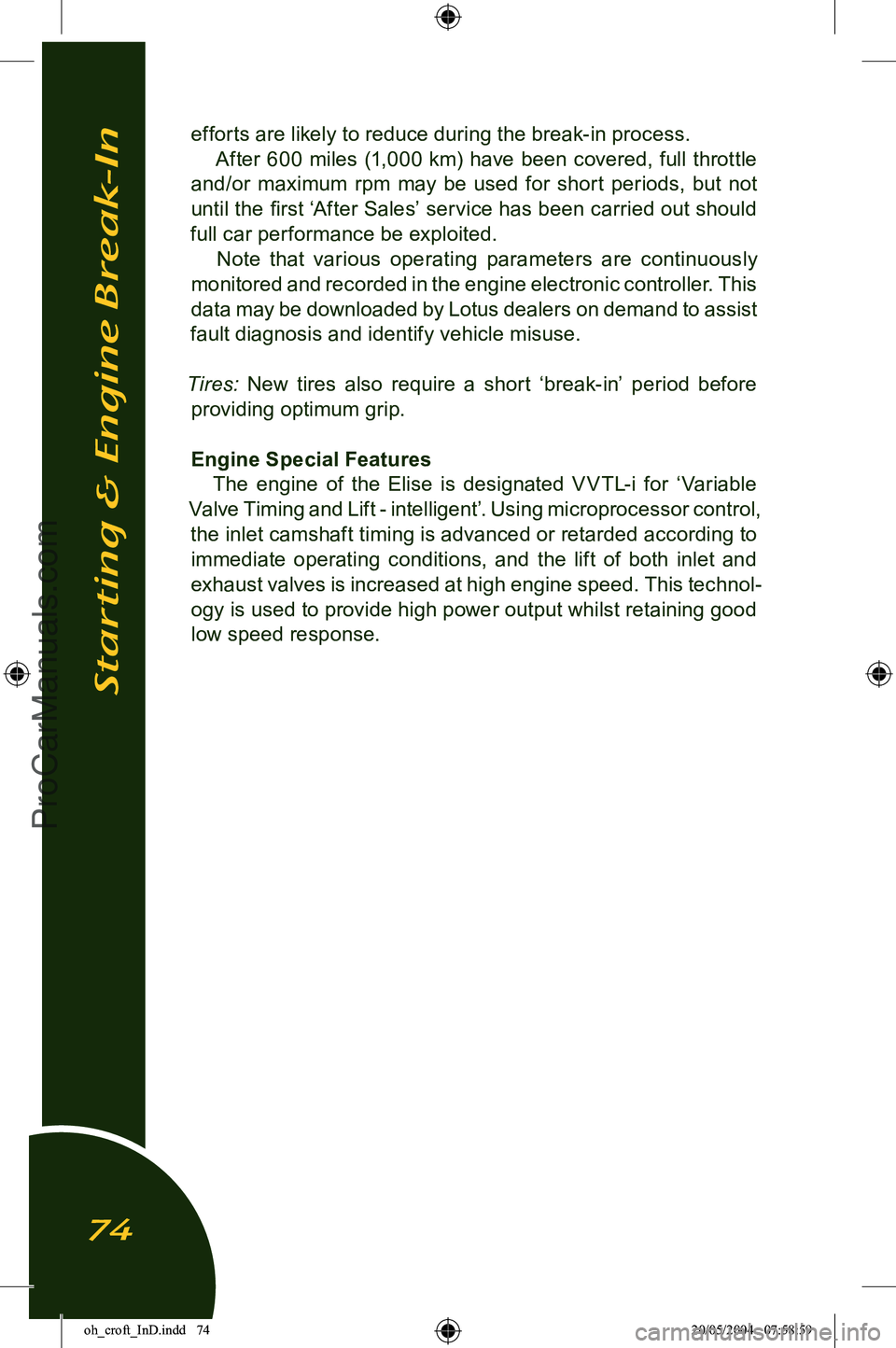
efforts are likely to reduce during the break-in process.After 600 miles (1,000 km) have been covered, full throttle
and/or maximum rpm may be used for short periods, but not
until the first ‘After Sales’ service has been carried out should
full car performance be exploited. Note that various operating parameters are continuously
monitored and recorded in the engine electronic controller. This
data may be downloaded by Lotus dealers on demand to assist
fault diagnosis and identify vehicle misuse.
Tires:
New tires also require a short ‘break-in’ period before
providing optimum grip.
Engine Special Features The engine of the Elise is designated V VTL-i for ‘Variable
Valve Timing and Lift - intelligent’. Using microprocessor control, the inlet camshaft timing is advanced or retarded according to
immediate operating conditions, and the lift of both inlet and
exhaust valves is increased at high engine speed. This technol
-
ogy is used to provide high power output whilst retaining good
low speed response.
Starting & Engine Break-In
74
oh_croft_InD.indd 7420/05/2004 07:58:59ProCarManuals.com
Page 77 of 205
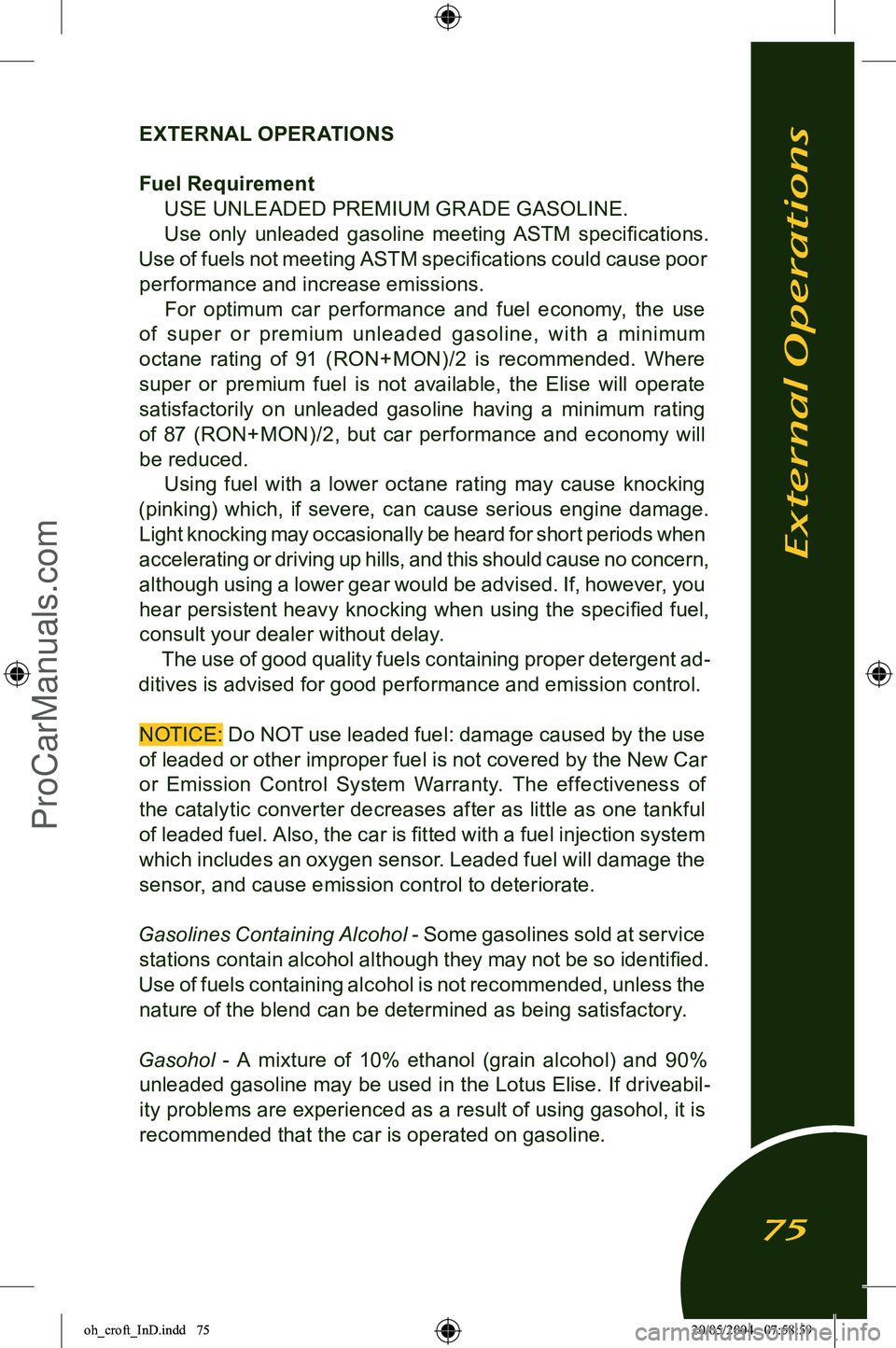
EXTERNAL OPERATIONS
Fuel Requirement USE UNLEADED PREMIUM GR ADE GASOLINE.
Use only unleaded gasoline meeting ASTM specifications.
Use of fuels not meeting ASTM specifications could cause poor performance and increase emissions.
For optimum car performance and fuel economy, the use
of super or premium unleaded gasoline, with a minimum
octane rating of 91 (RON+MON)/2 is recommended. Where
super or premium fuel is not available, the Elise will operate
satisfactorily on unleaded gasoline having a minimum rating
of 87 (RON+MON)/2, but car performance and economy will be reduced. Using fuel with a lower octane rating may cause knocking
(pinking) which, if severe, can cause serious engine damage.
Light knocking may occasionally be heard for short periods when accelerating or driving up hills, and this should cause no concern,
although using a lower gear would be advised. If, however, you hear persistent heavy knocking when using the specified fuel,
consult your dealer without delay.
The use of good quality fuels containing proper detergent ad
-
ditives is advised for good performance and emission control.
NOTICE: Do NOT use leaded fuel: damage caused by the use of leaded or other improper fuel is not covered by the New Car
or Emission Control System Warranty. The effectiveness of
the catalytic converter decreases after as little as one tankful
of leaded fuel. Also, the car is fitted with a fuel injection system
which includes an oxygen sensor. Leaded fuel will damage the sensor, and cause emission control to deteriorate.
Gasolines Containing Alcohol - Some gasolines sold at service stations contain alcohol although they may not be so identified.
Use of fuels containing alcohol is not recommended, unless the nature of the blend can be determined as being satisfactory.
Gasohol - A mixture of 10% ethanol (grain alcohol) and 90% unleaded gasoline may be used in the Lotus Elise. If driveabil
-
ity problems are experienced as a result of using gasohol, it is recommended that the car is operated on gasoline.
External Operations
75
oh_croft_InD.indd 7520/05/2004 07:58:59ProCarManuals.com
Page 78 of 205
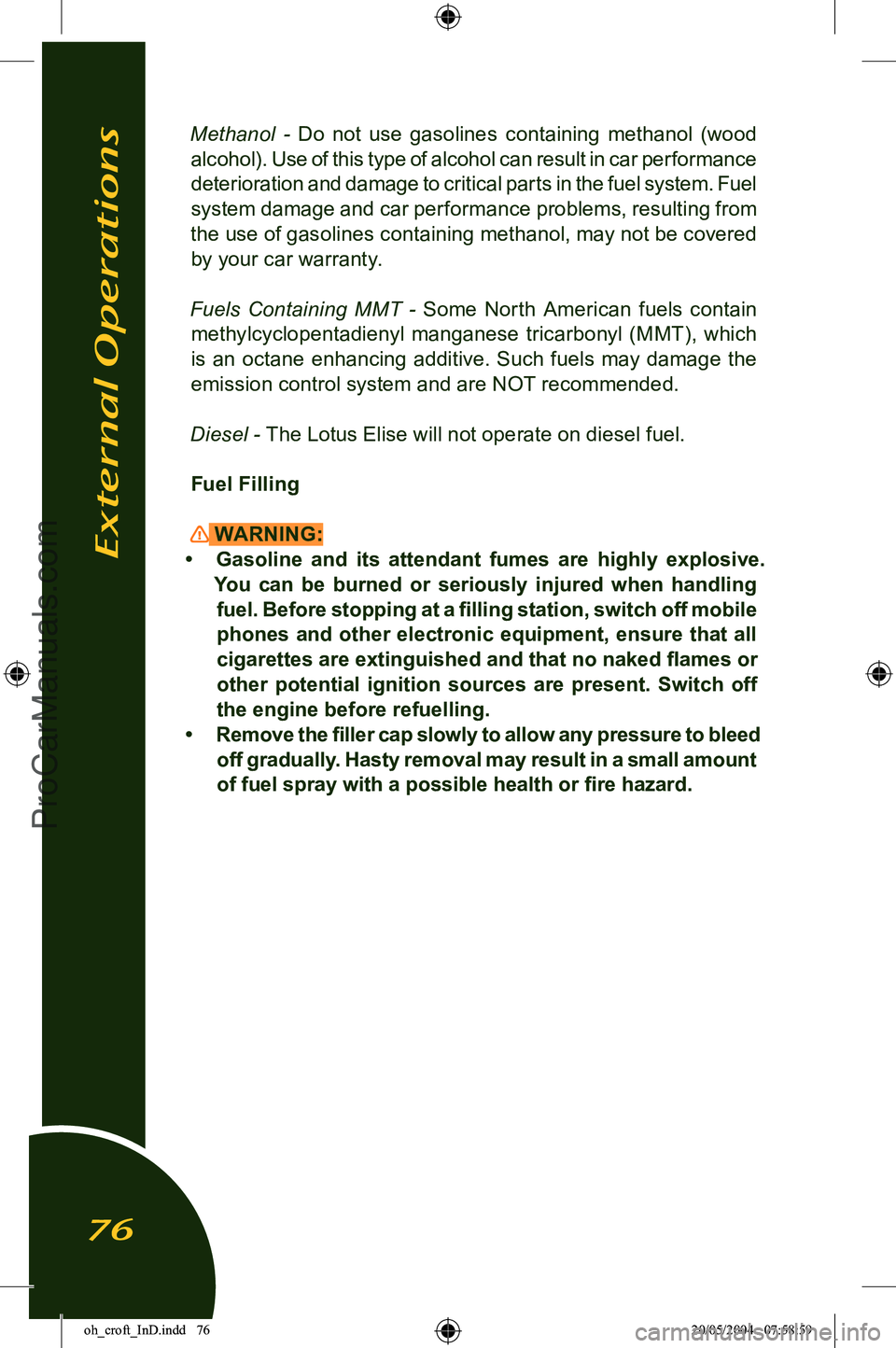
Methanol - Do not use gasolines containing methanol (wood
alcohol). Use of this type of alcohol can result in car performance deterioration and damage to critical parts in the fuel system. Fuel
system damage and car performance problems, resulting from
the use of gasolines containing methanol, may not be covered by your car warranty.
Fuels Containing MMT - Some North American fuels contain methylcyclopentadienyl manganese tricarbonyl (MMT), which
is an octane enhancing additive. Such fuels may damage the
emission control system and are NOT recommended.
Diesel
- The Lotus Elise will not operate on diesel fuel.
Fuel Filling
WARNING:
• Gasoline and its attendant fumes are highly explosive. You can be burned or seriously injured when handling
fuel. Before stopping at a filling station, switch off mobile phones and other electronic equipment, ensure that all
cigarettes are extinguished and that no naked flames or
other potential ignition sources are present. Switch off
the engine before refuelling.
• Remove the filler cap slowly to allow any pressure to bleed off gradually. Hasty removal may result in a small amount
of fuel spray with a possible health or fire hazard. External Operations
76
oh_croft_InD.indd 7620/05/2004 07:58:59ProCarManuals.com
Page 81 of 205
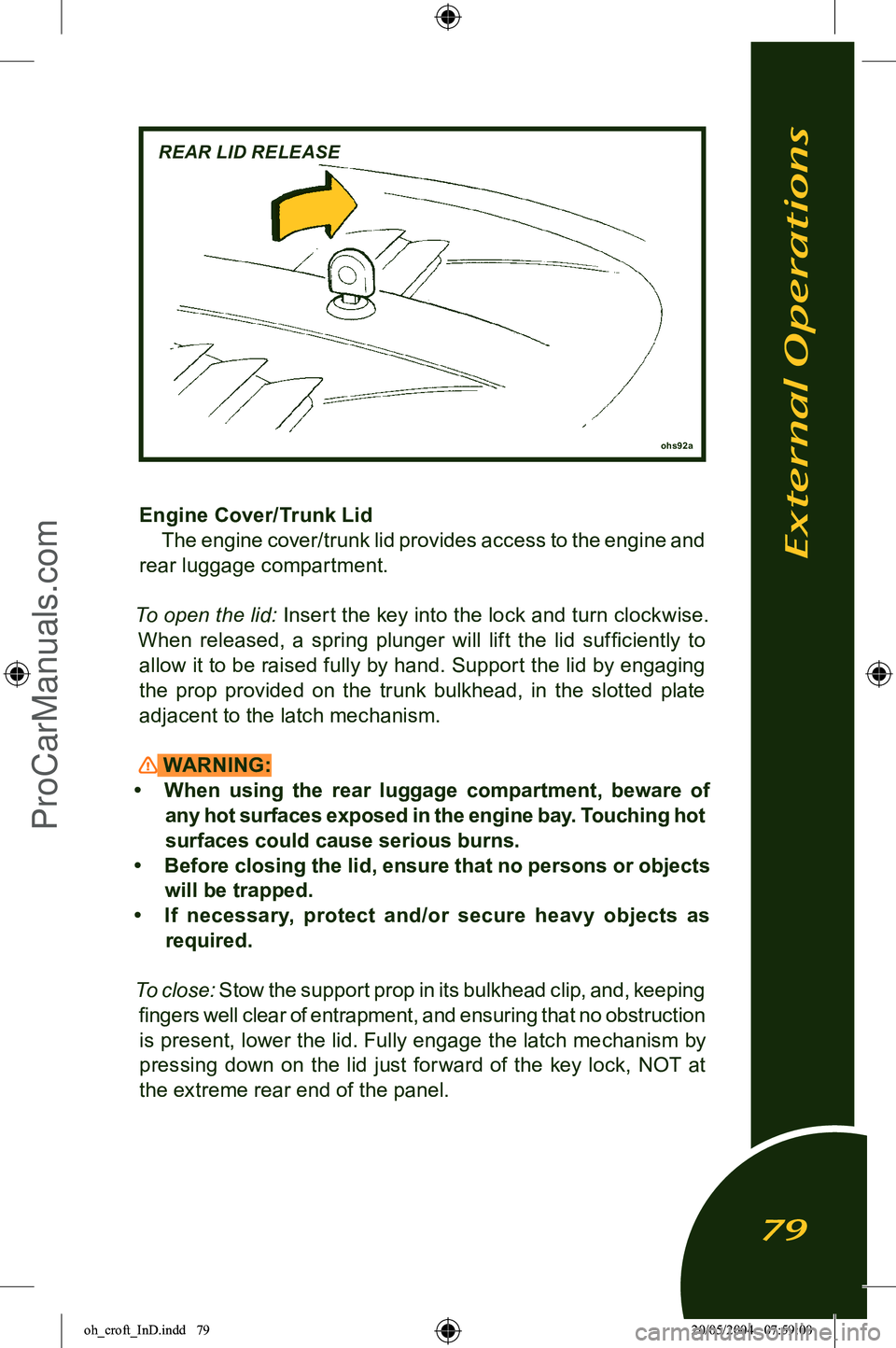
Engine Cover/Trunk LidThe engine cover/trunk lid provides access to the engine and
rear luggage compartment.
To open the lid: Insert the key into the lock and turn clockwise. When released, a spring plunger will lift the lid sufficiently to allow it to be raised fully by hand. Support the lid by engaging
the prop provided on the trunk bulkhead, in the slotted plate adjacent to the latch mechanism.
WARNING:
• When using the rear luggage compartment, beware of any hot surfaces exposed in the engine bay. Touching hot
surfaces could cause serious burns.
• Before closing the lid, ensure that no persons or objects
will be trapped.
• If necessary, protect and/or secure heavy objects as required.
To close: Stow the support prop in its bulkhead clip, and, keeping
fingers well clear of entrapment, and ensuring that no obstruction is present, lower the lid. Fully engage the latch mechanism by pressing down on the lid just forward of the key lock, NOT at
the extreme rear end of the panel.
ohs92a
REAR LID RELEASE
External Operations
79
oh_croft_InD.indd 7920/05/2004 07:59:00ProCarManuals.com
Page 100 of 205
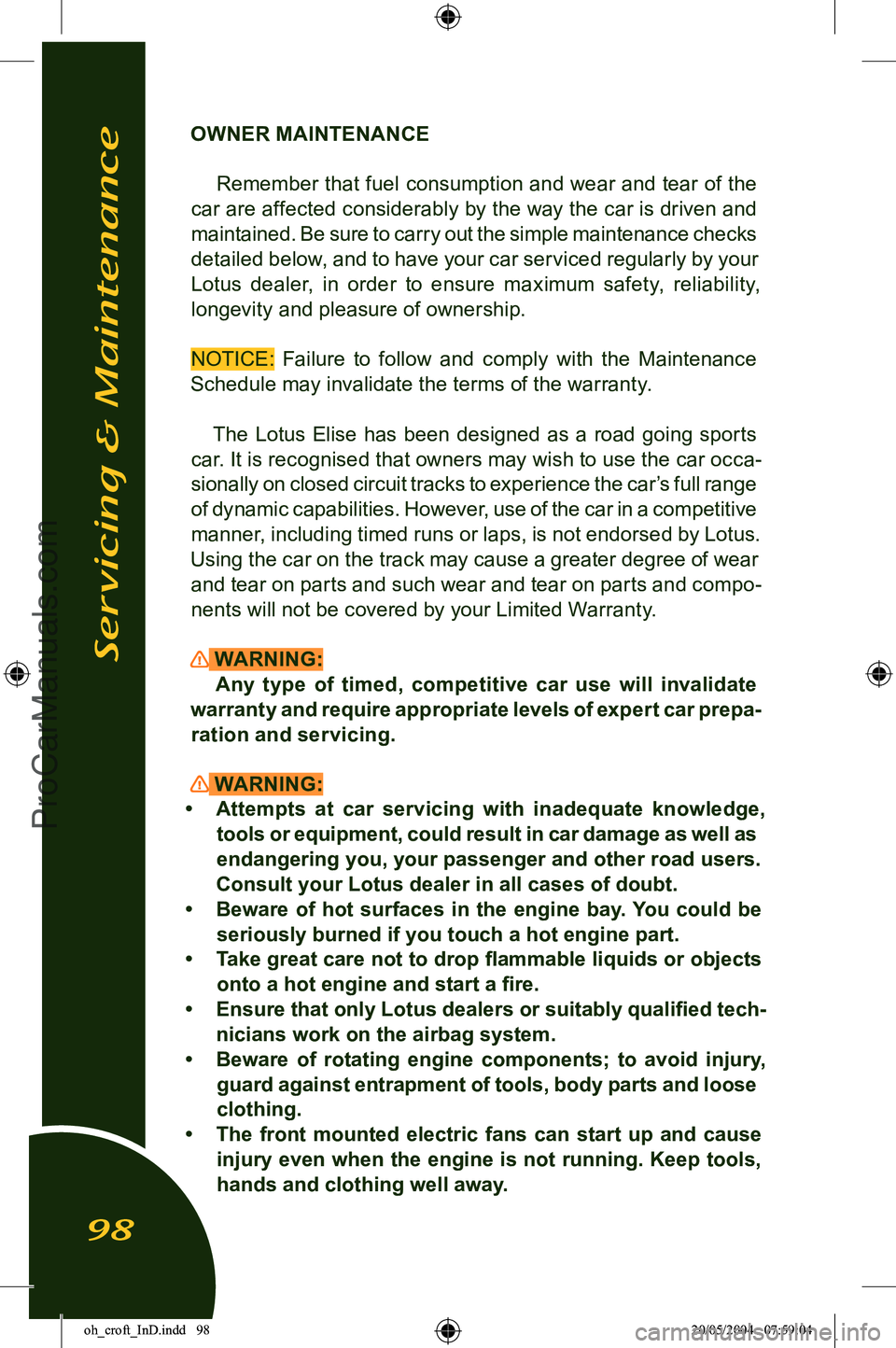
OWNER MAINTENANCERemember that fuel consumption and wear and tear of the
car are affected considerably by the way the car is driven and maintained. Be sure to carry out the simple maintenance checks detailed below, and to have your car serviced regularly by your
Lotus dealer, in order to ensure maximum safety, reliability,
longevity and pleasure of ownership.
NOTICE: Failure to follow and comply with the Maintenance
Schedule may invalidate the terms of the warranty.
The Lotus Elise has been designed as a road going sports
car. It is recognised that owners may wish to use the car occa
-
sionally on closed circuit tracks to experience the car’s full range of dynamic capabilities. However, use of the car in a competitive
manner, including timed runs or laps, is not endorsed by Lotus.
Using the car on the track may cause a greater degree of wear and tear on parts and such wear and tear on parts and compo
-
nents will not be covered by your Limited Warranty.
WARNING: Any type of timed, competitive car use will invalidate
warranty and require appropriate levels of expert car prepa
-
ration and servicing.
WARNING:
• Attempts at car servicing with inadequate knowledge, tools or equipment, could result in car damage as well as
endangering you, your passenger and other road users.
Consult your Lotus dealer in all cases of doubt.
• Beware of hot surfaces in the engine bay. You could be seriously burned if you touch a hot engine part.
• Take great care not to drop flammable liquids or objects onto a hot engine and start a fire.
• Ensure that only Lotus dealers or suitably qualified tech
-
nicians work on the airbag system.
• Beware of rotating engine components; to avoid injury,
guard against entrapment of tools, body parts and loose
clothing.
• The front mounted electric fans can start up and cause injury even when the engine is not running. Keep tools,
hands and clothing well away.
Servicing & Maintenance
98
oh_croft_InD.indd 9820/05/2004 07:59:04ProCarManuals.com
Page 101 of 205
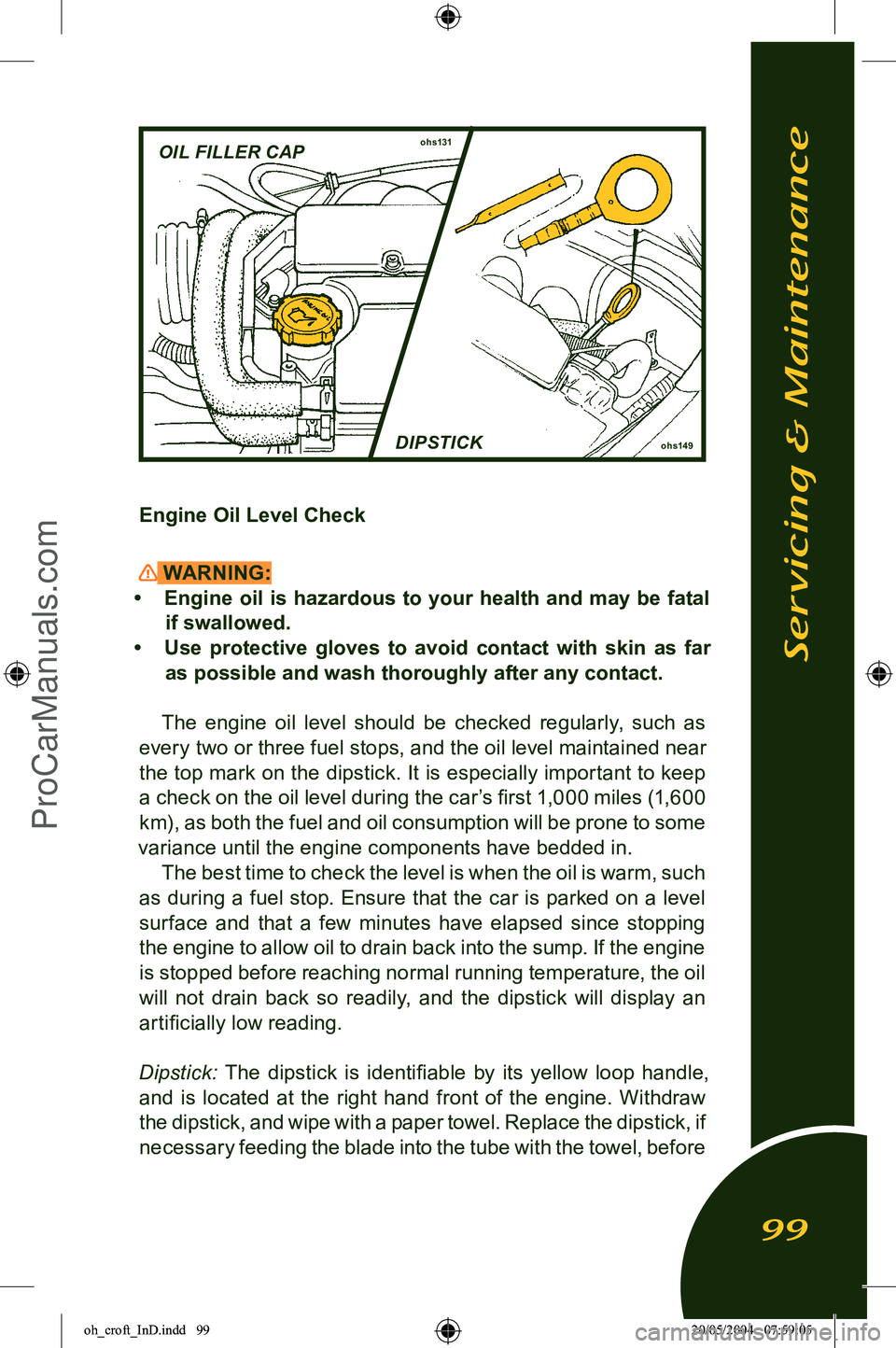
ohs149
OIL FILLER CAPohs131
DIPSTICK
Engine Oil Level Check
WARNING:
• Engine oil is hazardous to your health and may be fatal
if swallowed.
• Use protective gloves to avoid contact with skin as far as possible and wash thoroughly after any contact.
The engine oil level should be checked regularly, such as
every two or three fuel stops, and the oil level maintained near
the top mark on the dipstick. It is especially important to keep a check on the oil level during the car’s first 1,000 miles (1,600
km), as both the fuel and oil consumption will be prone to some
variance until the engine components have bedded in. The best time to check the level is when the oil is warm, such
as during a fuel stop. Ensure that the car is parked on a level
surface and that a few minutes have elapsed since stopping
the engine to allow oil to drain back into the sump. If the engine is stopped before reaching normal running temperature, the oil
will not drain back so readily, and the dipstick will display an artificially low reading.
Dipstick: The dipstick is identifiable by its yellow loop handle,
and is located at the right hand front of the engine. Withdraw
the dipstick, and wipe with a paper towel. Replace the dipstick, if necessary feeding the blade into the tube with the towel, before
Servicing & Maintenance
99
oh_croft_InD.indd 9920/05/2004 07:59:05ProCarManuals.com
Page 102 of 205
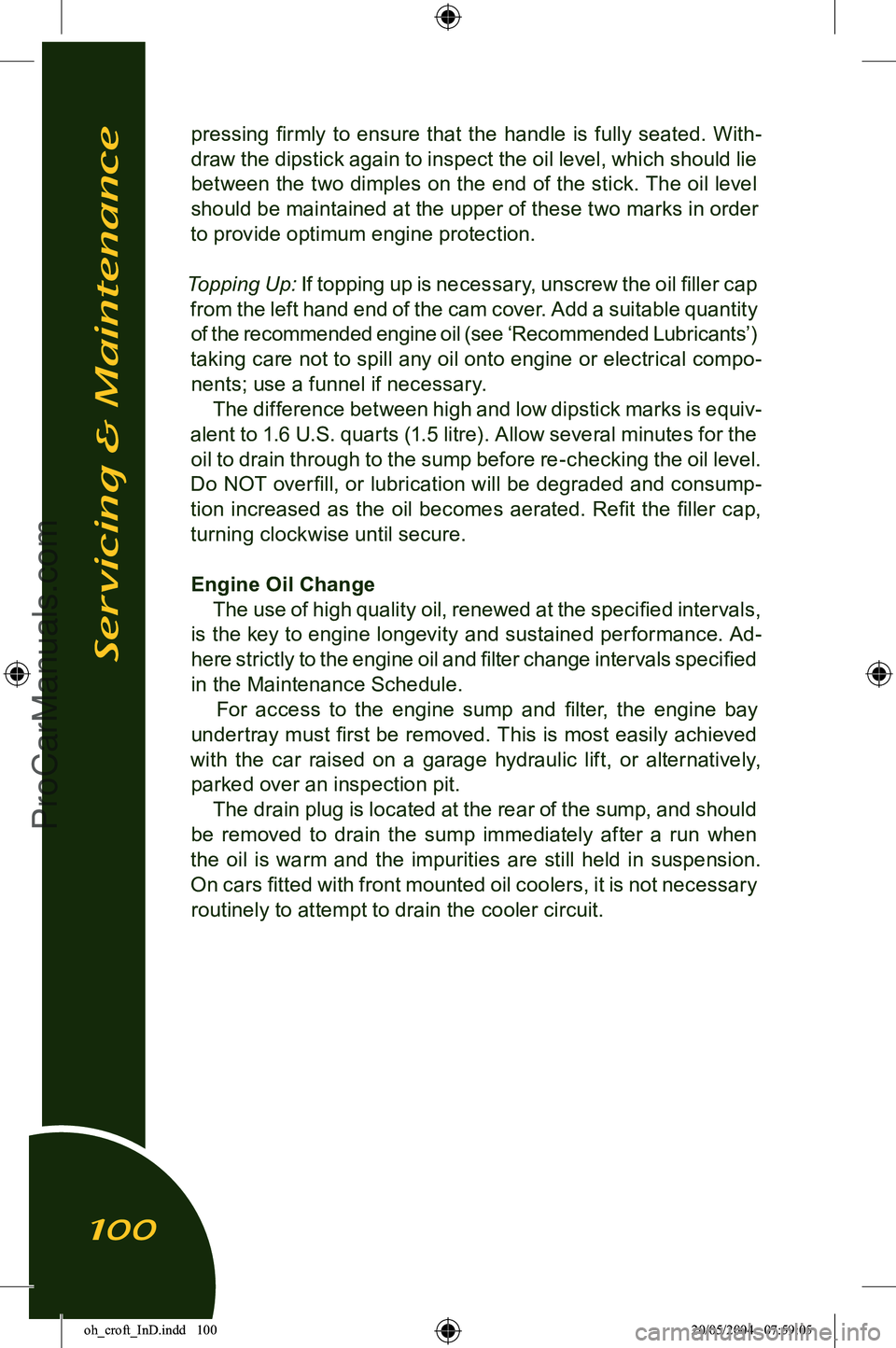
pressing firmly to ensure that the handle is fully seated. With-
draw the dipstick again to inspect the oil level, which should lie between the two dimples on the end of the stick. The oil level
should be maintained at the upper of these two marks in order
to provide optimum engine protection.
Topping Up
: If topping up is necessary, unscrew the oil filler cap
from the left hand end of the cam cover. Add a suitable quantity of the recommended engine oil (see ‘Recommended Lubricants’)
taking care not to spill any oil onto engine or electrical compo
-
nents; use a funnel if necessary. The difference between high and low dipstick marks is equiv
-
alent to 1.6 U.S. quarts (1.5 litre). Allow several minutes for the oil to drain through to the sump before re-checking the oil level.
Do NOT over fill, or lubrication will be degraded and consump
-
tion increased as the oil becomes aerated. Refit the filler cap,
turning clockwise until secure.
Engine Oil Change The use of high quality oil, renewed at the specified intervals,
is the key to engine longevity and sustained performance. Ad
-
here strictly to the engine oil and filter change intervals specified
in the Maintenance Schedule.
For access to the engine sump and filter, the engine bay
undertray must first be removed. This is most easily achieved
with the car raised on a garage hydraulic lift, or alternatively, parked over an inspection pit.
The drain plug is located at the rear of the sump, and should
be removed to drain the sump immediately after a run when
the oil is warm and the impurities are still held in suspension.
On cars fitted with front mounted oil coolers, it is not necessary routinely to attempt to drain the cooler circuit. Servicing & Maintenance
100
oh_croft_InD.indd 10020/05/2004 07:59:05ProCarManuals.com
Page 103 of 205
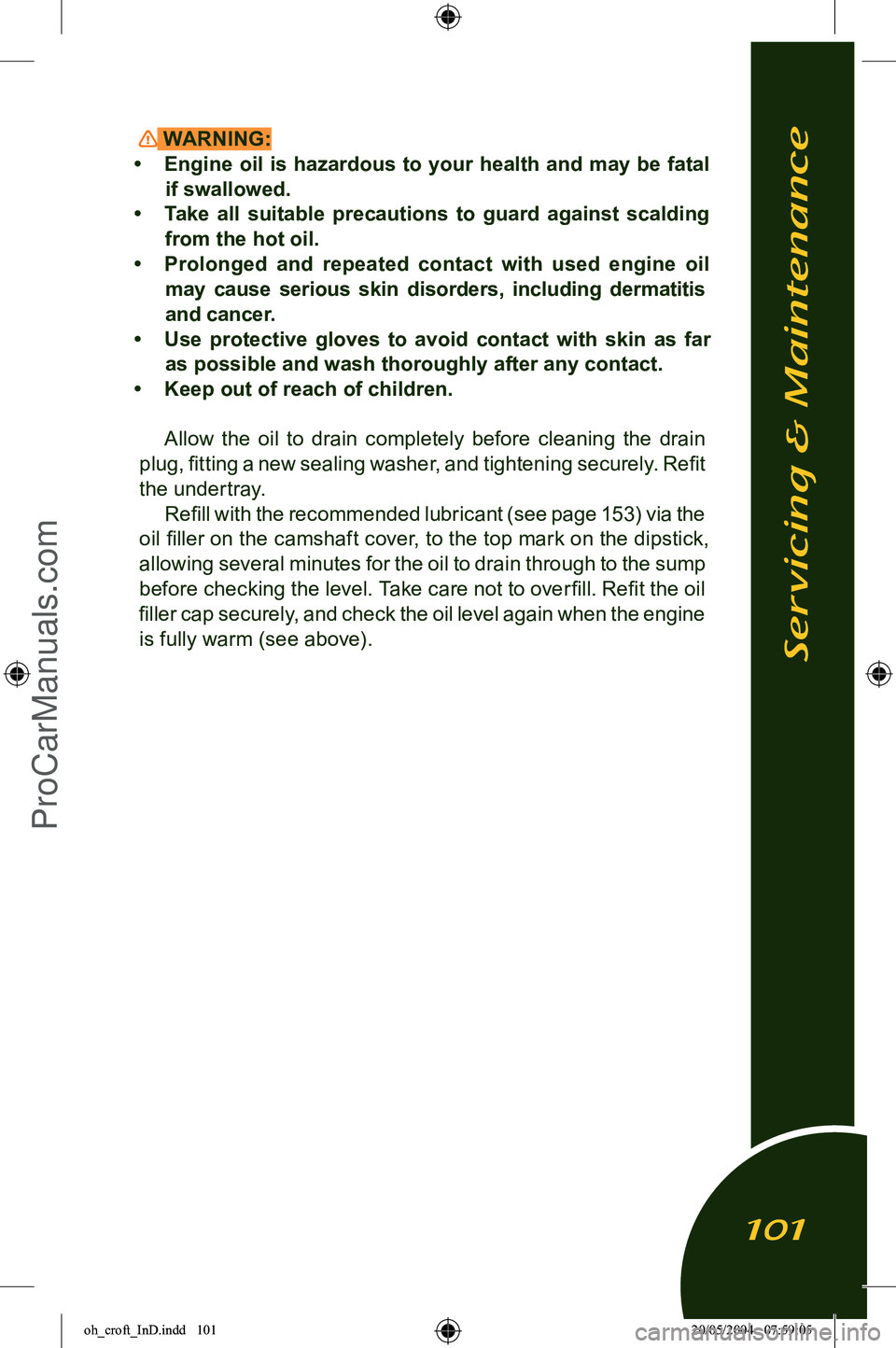
WARNING:
• Engine oil is hazardous to your health and may be fatal
if swallowed.
• Take all suitable precautions to guard against scalding
from the hot oil.
• Prolonged and repeated contact with used engine oil may cause serious skin disorders, including dermatitis
and cancer.
• Use protective gloves to avoid contact with skin as far
as possible and wash thoroughly after any contact.
• Keep out of reach of children.
Allow the oil to drain completely before cleaning the drain
plug, fitting a new sealing washer, and tightening securely. Refit
the undertray. Refill with the recommended lubricant (see page 153) via the
oil filler on the camshaft cover, to the top mark on the dipstick,
allowing several minutes for the oil to drain through to the sump before checking the level. Take care not to over fill. Refit the oil
filler cap securely, and check the oil level again when the engine is fully warm (see above).
Servicing & Maintenance
101
oh_croft_InD.indd 10120/05/2004 07:59:05ProCarManuals.com